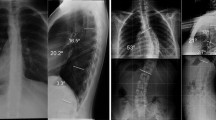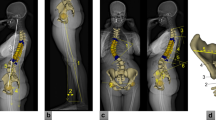Abstract
The aim of this study is to describe the radiological changes in rib–vertebral angles (RVAs), rib–vertebral angle differences (RVADs), and rib–vertebral angle ratios (RVARas) in patients with untreated right thoracic adolescent idiopathic scoliosis and to compare with the normal subjects. The concave and convex RVA from T1 to T12, the RVADs and the RVARas were measured on AP digital radiographs of 44 female patients with right convex idiopathic scoliosis and 14 normal females. Patients were divided into three groups: normal subjects (group 1), scoliotic patients with Cobb’s angle equal or <30° (group 2) and scoliotic patients with Cobb’s angle over 30° (group 3). Overall values (mean ± SD) of the RVAs on the concave side were 90.5° ± 17° in group 1, 90.3° ± 15.8° in group 2 and 88.8° ± 15.4° in group 3. On the convex side, values were 90.0° ± 17.3° in group 1, 86.3° ± 13.7° in group 2 and 80.7° ± 14.4° in group 3. Overall values (mean ± SD) of the RVADs at all levels were 0.5° ± 0.7° in group 1, 4.0° ± 4.8° in group 2 and 8.0° ± 4.0° in group 3. The RVARa values (mean ± SD) at all levels was 1.008° ± 0.012° in group 1, 1.041° ± 0.061° in group 2 and 1.102° ± 0.151° in group 3. RVAD and RVARa values in the scoliotic segment were greater in patients with untreated scoliosis over 30° than in patients with an untreated deformity of <30° or normal subjects. A significant effect between groups was observed for the RVA, RVAD and RVARa variables. Measurement of RVA, RVAD and RVARa should not only be performed at and around the apex of a thoracic spinal deformity, but also extended to the whole thoracic spine.

Similar content being viewed by others
References
Oda I, Abumi K, Lü D et al (1996) Biomechanical role of the posterior elements, costovertebral joints, and rib cage in the stability of the thoracic spine. Spine 21:1423–1429
Oda I, Abumi K, Cunningham B et al (2002) An in vitro human cadaveric study investigating the biomechanical properties of the thoracic spine. Spine 27:E64–E70
Watkins R IV, Watkins R III, Williams L et al (2005) Stability provided by the sternum and rib cage in the thoracic spine. Spine 30:1283–1286
Sevastik B, Xiong B, Sevastik J et al (1997) Rib–vertebral angle asymmetry in idiopathic, neuromuscular and experimentally induced scoliosis. Eur Spine J 6:84–88
Mehta MH (1972) The rib vertebral angle in the early diagnosis between resolving and progressive infantile scoliosis. J Bone Joint Surg Br 54:230–243
Kristnundsdottir F, Burwell RG, James IP (1985) The rib–vertebra angles on the convexity and concavity of the spinal curve in infantile idiopathic scolisosis. Clin Orthop Relat Res 201:205–209
Modi H, Suh SW, Song HR et al (2009) Drooping of apical convex rib vertebral angle in adolescent idiopathic scoliosis of more than 40 degrees. A prognostic factor for progression. J Spinal Disord Tech 22:367–371
Grivas TB, Samelis P, Chadziargiropoulos T et al (2002) Study of rib cage deformity in children with 10 degrees–20 degrees of Cobb angle late onset idiopathic scoliosis, using rib–vertebra angles-etiologic implications. Stud Health Technol Inform 91:20–24
Grivas TB, Burwell RG, Purdue M et al (1992) Segmental patterns of rib–vertebra angles in chest radiographs of children: changes related to rib level, age, sex, side and significance for scoliosis. Clin Anat 5:272–288
Wojcik AS, Webb JK, Burwell RG (1990) An analysis of the Zielke operation on the rib-cage of S-shaped curves in idiopathic scoliosis. Spine 15:81–86
Taylor JF, Roaf R, Owen G et al (1983) Costodesis and contralateral rib release in the management of progressive scoliosis. Acta Orthop Scand 54:603–612
McAlimdon RJ, Kruse RW (1997) Measurement of rib–vertebral angle difference. Intraobserver error and interobserver variation. Spine 22:198–199
Mannherz RE, Betz RR, Clancy M et al (1988) Juvenile idiopathic scoliosis followed to skeletal maturity. Spine 13:1087–1090
Cobb JR (1948) Outline for the study of scoliosis. Instr Course Lect 5:261–275
Xiong B, Sevastik JA, Hedlund R, Sevastik B (1994) Radiographic changes at the coronal plane in early scoliosis. Spine 19:159–164
Burwell RG, Aujla RK, Freeman BJ et al (2008) The posterior skeletal thorax: rib–vertebral angle and axial vertebral rotation asymmetries in adolescent idiopathic scoliosis. Stud Health Technol Inform 140:263–268
Andriacchi T, Schultz A, Belytschko T et al (1974) A model for studies of mechanical interactions between the human spine and rib cage. J Biomech 7:497–507
Thometz JG, Liu XC, Lyon R (2000) Three-dimensional rotations of the thoracic spine after distraction with and without rib resection: a kinematic evaluation of the apical vertebra in rabbits with induced scoliosis. J Spinal Disord 13:108–112
Burwell RG, Cole AA, Cook TA et al (1992) Pathogenesis of idiopathic scoliosis. The Nottingham concept. Acta Orthop Belg 58:33–58
Conflict of interest
None.
Author information
Authors and Affiliations
Corresponding author
Rights and permissions
About this article
Cite this article
Canavese, F., Turcot, K., Holveck, J. et al. Changes of concave and convex rib–vertebral angle, angle difference and angle ratio in patients with right thoracic adolescent idiopathic scoliosis. Eur Spine J 20, 129–134 (2011). https://doi.org/10.1007/s00586-010-1563-y
Received:
Revised:
Accepted:
Published:
Issue Date:
DOI: https://doi.org/10.1007/s00586-010-1563-y




